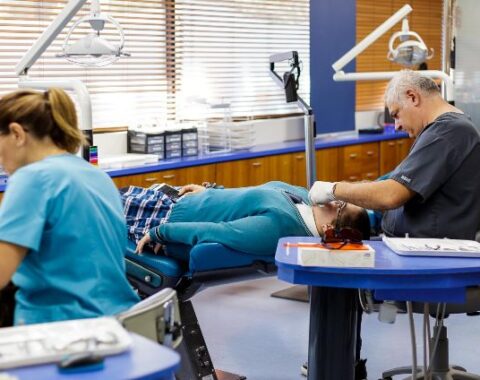Elastics are an important part of treatment for many people with braces. They are used to treat misaligned teeth including an overbite, underbite, open bite and crossbite. The elastic bands work by applying additional force to certain areas of the mouth to move the teeth into the desired position. Wearing elastics can reduce the treatment time for braces, so it’s important to understand how they work.
Two Kinds of Elastics
When it comes to braces, there are two kinds of elastics. The tiny little rings that sit around each bracket are applying pressure to the teeth to help move them into the desired position. You can choose to have a natural coloured elastic, or mix things up and choose different colours for these elastics. They’re changed at each appointment with your orthodontist, but you wear these elastics around the brackets for the duration of your braces treatment.
The elastics that sit between the top and bottom jaws are what most people think of when you mention elastics. Not everyone with braces needs these elastics as they are most often used to help with jaw alignment. There are various types of elastics to do different jobs.
Class 1 – Used to close gaps between teeth.
Class 2 – Used to pull the upper teeth back and move the lower teeth forward
Class 3 – Used to pull the lower teeth back and the upper teeth forward
The degree of force the elastic bands provide are measured in three categories – light, medium and heavy. The bands come in different sizes which is measured by the diameter of the bands, usually in fractions of an inch.
Length of Time Wearing Elastics
Some people will only need to wear elastics for several weeks because their teeth don’t need to move far and/or their teeth move quickly. For other patients with significant bite issues, they may need to wear the elastics for a year or more. For the fastest results, patients should wear the elastics almost all of the time. If you aren’t eating or brushing your teeth, you should wear elastics. Leaving the elastics off for long periods can mean you need to wear them for longer to achieve the same result.
Elastics aren’t just for people with braces. Elastics can be used for those people undergoing Invisalign treatment. Rather than hooks like you see on braces, the elastics attach to small buttons on the aligners.
FAQs for Wearing Elastic Bands With Braces
Below are some of the questions patients most often ask about elastic bands.
Will I need elastics?
Not everyone with braces needs elastics. Your orthodontist will prepare a treatment plan around the time your braces are fitted so you can ask then if elastics will be part of your treatment.
How do I put the elastics on?
Your orthodontist will show you where the tiny hooks are on your braces to attach the rubber bands. Hold the elastic between your thumb and finger and place the bands on the top and bottom of your teeth. Try not to stretch the elastic too much between your fingers. Stretching can reduce the strength and effectiveness of the band.
Like anything, elastics take a little practise to take on and off but you’ll get the hang of it within a few days.
Are elastic bands safe?
There are few side effects from wearing elastic bands. Tell your orthodontist if you have an allergy to latex as there are synthetic bands available. Remember to wash your hands before attaching or removing elastic bands on your teeth so you don’t introduce germs into your mouth. It doesn’t happen often but the rubber band may break while you’re wearing elastics. If this does happen, it doesn’t hurt much because the bands are so small and thin.
Will it be painful wearing elastic bands for the first time?
The elastic bands may cause a little discomfort when you first start wearing them. You can take an over the counter painkiller to reduce the discomfort of sore or aching teeth.
Will I get elastics as soon as my braces go on?
If you need to wear elastics they are usually added later in your treatment, not the same time as you have your braces fitted.
Do I need to wear the elastics all the time?
Your orthodontist will instruct you on how often you need to wear them but the majority of patients will wear elastics day and night. To ensure you achieve the fastest result, keep your elastics in unless you need to eat, brush and floss your teeth. Keep a packet of spare elastic bands with you wherever you go in case you need a new one.
Do I wear the same elastics all the time?
Elastic bands lose their effectiveness with time as they stretch. It’s best to use fresh elastics each time you take your elastics off to eat or brush your teeth.
If you have any queries about elastics or you expect to run out of elastics before your next appointment, call your orthodontist and let them know you’re running low on supplies.





